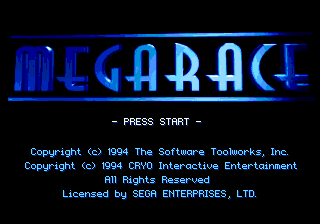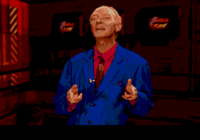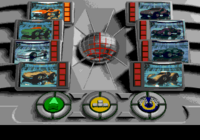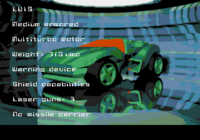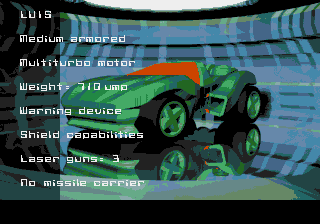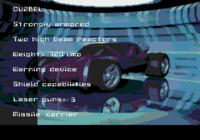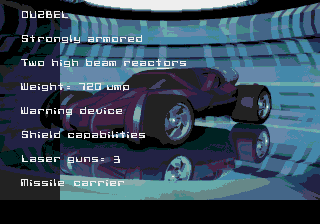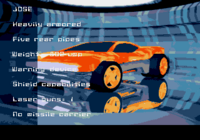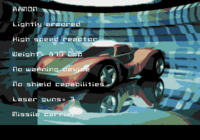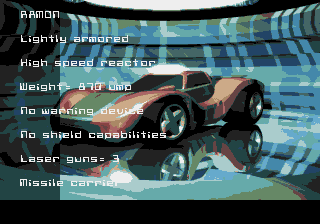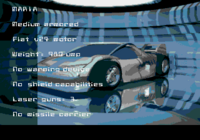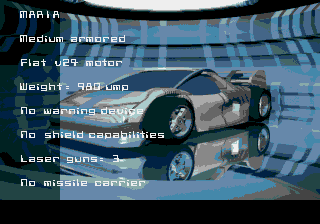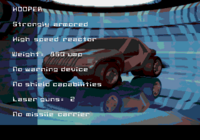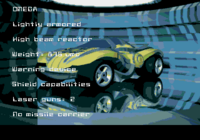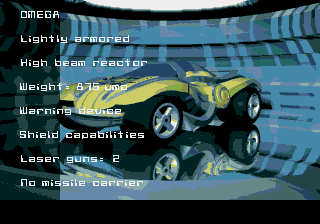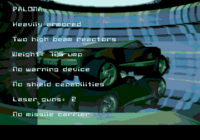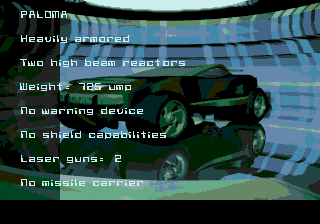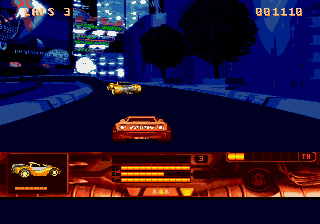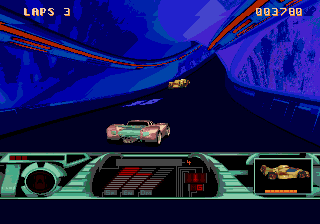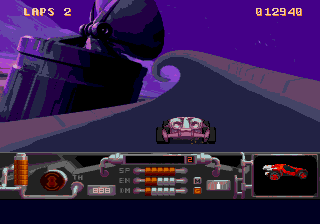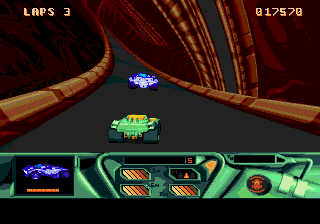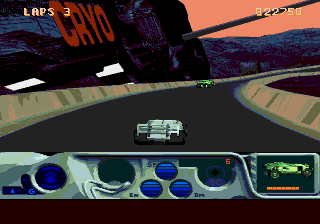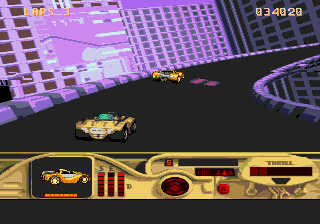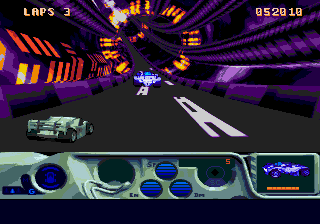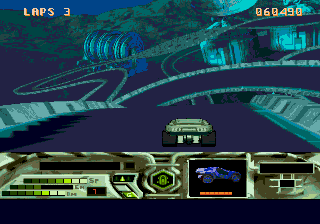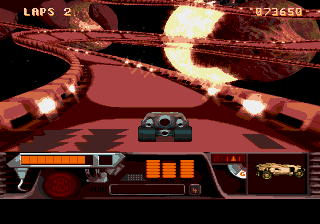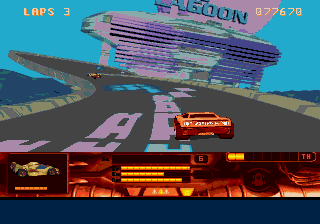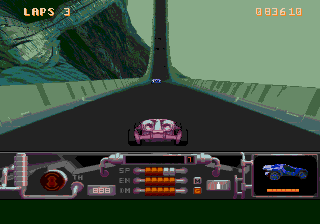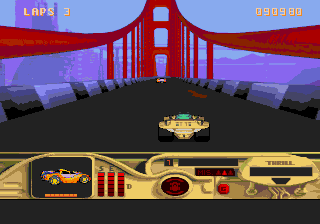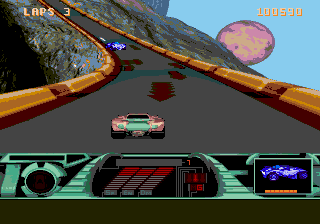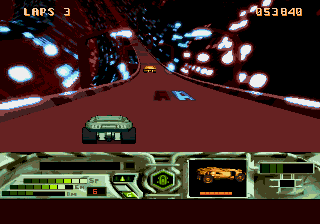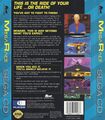MegaRace
From Sega Retro
| MegaRace | ||||||||||
|---|---|---|---|---|---|---|---|---|---|---|
| System(s): Sega Mega-CD | ||||||||||
| Publisher: The Software Toolworks | ||||||||||
| Developer: Cryo Interactive Entertainment | ||||||||||
| Genre: Racing | ||||||||||
| Number of players: 1 | ||||||||||
| ||||||||||
|
MegaRace is a Sega Mega-CD racing and shooting game developed by Cryo Interactive Entertainment and published by The Software Toolworks.
Despite being an European game (and being advertised in Europe, to be published under the Mindscape brand), the Mega-CD version was only released in North America. It was given a supposed release date of May 1994 in the UK.[1]
Contents
Story
The game takes place in the distant future, where the player is an "Enforcer," a contestant on a fictional game show MegaRace. The show is broadcast on the fictional VWBT (Virtual World Broadcast Television) television channel, where contestants compete in life-or-death races against gangs of "speed punks." The show's host is the eccentric Lance Boyle, who guides the player throughout the game, introducing new locations and enemies and frequently discouraging the player.
Gameplay
MegaRace is a futuristic racing game set in a virtual world. It is one of several racing games produced around this period where tracks are represented entirely by full-motion video. The car can only accelerate and brake within a narrow range (and cannot be brought to a complete stop). "Turning" only changes the horizontal position of the car on-screen, similar to a rail shooter, rather than steering; the car navigates the twists and turns of the course without player intervention since it is a prerendered video. The objective is to destroy all of the opponents on the track before three laps of the racetrack are completed. The player must also selectively avoid or run over symbols marked on the speedway, which temporarily improve or impair the car's performance. The first race starts out with a small number of opponents, but more are added in each subsequent race. There is only ever one other racer at a time, with the next opponent appearing after the previous one has been destroyed.
The car is moved with ![]() and
and ![]() . It accelerates with
. It accelerates with ![]() and brakes with
and brakes with ![]() (but there are two alternative control schemes that map these to
(but there are two alternative control schemes that map these to ![]() and
and ![]() instead). The player can dispatch opponents by slamming them into the sidewall of the track or hitting them with guns or missiles. Furthermore, opponents explode after the gap between the two cars becomes too great, though they usually rubberband back to the player if passed. Car are initially equipped with a single gun, but they can add up to two more guns by driving over road symbols. Some cars can also acquire missiles from symbols. Weapons are fired with
instead). The player can dispatch opponents by slamming them into the sidewall of the track or hitting them with guns or missiles. Furthermore, opponents explode after the gap between the two cars becomes too great, though they usually rubberband back to the player if passed. Car are initially equipped with a single gun, but they can add up to two more guns by driving over road symbols. Some cars can also acquire missiles from symbols. Weapons are fired with ![]() but cost energy to fire (with missiles costing more energy than guns).
but cost energy to fire (with missiles costing more energy than guns).
There are multiple selectable cars. Before each race, the player is presented with a car selection screen, which is navigated with ![]() and
and ![]() . The player can view a 3D model and information about a car by selecting it and pressing
. The player can view a 3D model and information about a car by selecting it and pressing ![]() or can start the race with the selected car by pressing START . The green button allows the player to set the difficulty level (Novice or Hardened). The yellow button contains options for loading or saving the game, changing the control scheme, and quitting the game. The blue button shows the high score table.
or can start the race with the selected car by pressing START . The green button allows the player to set the difficulty level (Novice or Hardened). The yellow button contains options for loading or saving the game, changing the control scheme, and quitting the game. The blue button shows the high score table.
During a race, the status area on the bottom of the screen differs in appearance depending on which car is being driven but contains the same information. The three bars in the center are a speed meter (SP), energy meter (EN), and damage meter (DM). The car cannot fire its weapon when the energy meter is exhausted, and it is destroyed when the damage meter is emptied. One side of the status area (depending on the car) shows the current enemy's car and damage meter. The other side shows the "Thrill-O-Meter" (TH), which gauges the audience's excitement with the race and increases as the player engages in vehicular combat and destroys opponents. A counter shows the number of opponents remaining.
When all opponents are successfully dispatched, the player moves on to the next race. The game ends if the player's car is destroyed or if the player fails to kill all opponents before the end of the last lap. Occasionally, after failing a race, the player is given the opportunity to compete in the Last Chance Speedway, a special course that must be won to continue. Otherwise, the player must start again from the last saved game in order to continue.
Cars
The first three cars are initially available. The other cars are earned after defeating their owners in the first five races. Cars are rated on weapons, armor, ease of control, and "Techno" (support for special devices such as shields awarded by certain road symbols).
The Ouzbel and Ramon cars are equipped with missile launchers.
Symbols
Symbols appear on the road and cause certain effects when they are driven over. Enemy racers are not affected by driving over symbols.
Beneficial
Beneficial symbols are light in color.
| Booster + | |
|---|---|
| Gives the car a temporary speed boost. | |
| Points + | |
| Awards points. | |
| Energy + | |
| Increases the car's energy meter (ammunition). | |
| Weapon | |
| Adds another weapon to the car, allowing it to fire up to three guns at once. | |
| Missile | |
| Changes the car's armament from guns to missiles. Only affects cars that are equipped with missile launchers (the Ouzbel and the Ramon). | |
| Rails | |
| Holds the car onto the rail, giving it a boost of speed while it is held. | |
| Shield | |
| Temporarily shields the car from damage. Only affects cars that have shield support. | |
| Warning | |
| Activates the car's warning indicator, which shows upcoming symbols. |
Detrimental
Beneficial symbols are dark in color.
| Booster – | |
|---|---|
| Causes the car to brake and slow down. | |
| Points – | |
| Takes away points. | |
| Energy – | |
| Decreases the car's energy meter (ammunition). | |
| No Weapon | |
| Strips the car of all weapons. | |
| Radar Jam | |
| Temporarily jams the car's radar, making it unable to see the locations of enemy cars. | |
| Blinding Zone | |
| Temporarily causes the screen to ripple and wobble, obscuring the player's vision. | |
| Panel Off | |
| Temporarily disables the car's warning monitor (if activated) and causes all information in the status area to vanish. | |
| Inverter | |
| Inverts the car's steering controls. | |
| Skidding | |
| Forces the car to skid and become unable to steer. | |
| Skidding Turn | |
| Forces the car to spin in a circle, impairing its ability to turn and shoot. |
Tracks
There are five areas, each defended by a different gang:
- NewSan: New San Francisco, a futuristic urban environment. Home of the Vultures and their leader Jailbait, who drive Ramons.
- Maeva: An underwater world. Home of the Sharks and their leader Hammerhead, who drive Marias.
- Factoryland: An industrial district. Home of the Power Tools and their leader Big Bob, who drive Hoopers.
- Fractalian Space: Extraterrestrial locations. Home of the Master Class and their leader King Cool, who drive Omegas.
- Terminal City: A landfill located outside of NewSan. Home of the Scabs and their leader Rabies, who drive Palomas.
| Uptown (NEWSAN 1) | |
|---|---|
|
World: NewSan Opponents: 4 | |
| Atlantis (MAEVA 1) | |
|
World: Maeva Opponents: 5 | |
| Industrial Park (NEWFAC 1) | |
|
World: Factoryland Opponents: 5 | |
| The Belly of the Beast (NGLOOP) | |
|
World: Fractalian Space Opponents: 5 | |
| Wasteland (SUBURB) | |
|
World: Terminal City Opponents: 6 | |
| Sunset Boulevard (NEWSAN 2) | |
|
World: NewSan Opponents: 6 | |
| Aqualand (MAEVA 2) | |
|
World: Maeva Opponents: 7 | |
| The Particle Accelerator (PARTICLE) | |
|
World: Fractalian Space Opponents: 5 | |
| The Snake (NEWFAC 2) | |
|
World: Factoryland Opponents: 7 | |
| Orbital Junkyard (JUNKYARD) | |
|
World: Terminal City Opponents: 7 | |
| The Blue Lagoon Funworld (MAEVA 3) | |
|
World: Maeva Opponents: 7 | |
| The Big Zero (NEWFAC 3) | |
|
World: Factoryland Opponents: 7 | |
| Golden Gate Speedway (NEWSAN 3) | |
|
World: NewSan Opponents: 7 | |
| Paradise Valley (LAST) | |
|
World: Fractalian Space Opponents: 7 | |
Special tracks
| The Skyholder (HOLDER) | |
|---|---|
| This is an extra race played after every three normal races for bonus points. Only Points + and Points – symbols appear on the road. The player's car has no weapons and crashes if it touches any other car. Crashing ends the race but not the game. | |
| The Last Chance Speedway (TOKYO) | |
|
Opponents: 5 | |
| The game normally ends if the player fails to kill all opponents in a race. Sometimes, however, the player is given the chance to compete in the Last Chance Speedway (also called "The Can"). The player must win this race in order to continue. |
Music and sound
In-game music is not streamed off the CD, instead being generated by the sound chips of the Mega Drive.
History
Legacy
MegaRace was followed by MegaRace 2 for DOS in 1996 and MegaRace 3 for Windows and the PlayStation 2 in 2002.
Production credits
- Created by: Cryo Interactive Entertainment
- Graphics: Frank de Luca, Madjid Taibi
- Additional Graphics: Philippe Lamoureux, Florian Desforges
- Bitmap Graphics: Daniele Herbulot
- Renders & Gameplay: Florian Desforges
- Program: Olivier Robin (Haiku Studios), Olivier Crozet (Haiku Studios), Pascal Urro, Remi Herbulot
- Programmer: Eric Safar
- Music & Sounds: Stephane Picq
- TV Host: Christian Erikson
- Texts: Johan Robson
- Shooting Crew: Johan Robson, Olivier Levy, Philippe Jedar, Remi Herbulot, Daniele Herbulot
- Video Digits: Daniele Herbulot, Remi Herbulot
- Producers: Simon Harris, Steve Hutchins
- US Product Manager: Greg Dawson
- Game Testing: Jon Howe, Hugh Mason, Craig Brisgel, Daryl Bunting, James Thornton III, Scott Van Schoick, Danny Isaac, Neil Soane
- Documentation: Karl Fitzhugh, Anne O'Brien, Bill Duncan, Clive Fort
- Special Thanks To: Jean-Martial LeFranc, Jim Fisher, Jim Molitor, George M., Steve Whittle, Juliet Pitt, Greno, Inspector Preston of US Customs, Carol Shelby, S.C.T.A., Lee Singleton, Mindscape Technical Services
- Directed By: Remi Herbulot
- Produced By: Steve Hutchins
- Technical Support: Dave Locke
- Technical Support Manage: Dave Buoncristiani
- Packaging, Documentation, and Marketing: Myrna Peskin, Anne O'Brien, Julie A. Lippold, Ruth A. Weston, Beeline Group, Inc.
Magazine articles
- Main article: MegaRace/Magazine articles.
Promotional material
also published in:
- Electronic Gaming Monthly (US) #59: "June 1994" (1994-xx-xx)[3]
Physical scans
| Sega Retro Average | |||||||||||||||||||||||||||||||||||||||||||||||||
|---|---|---|---|---|---|---|---|---|---|---|---|---|---|---|---|---|---|---|---|---|---|---|---|---|---|---|---|---|---|---|---|---|---|---|---|---|---|---|---|---|---|---|---|---|---|---|---|---|---|
|
| 67 | |
|---|---|
| Based on 9 reviews | |
Technical information
- Main article: MegaRace/Technical information.
ROM dump status
| System | Hash | Size | Build Date | Source | Comments |
|---|
References
- ↑ Computer & Video Games, "May 1994" (UK; 1994-04-15), page 78
- ↑ File:Megarace mcd us manual.pdf, page 22
- ↑ Electronic Gaming Monthly, "June 1994" (US; 1994-xx-xx), page 26
- ↑ Consoles +, "Septembre 1994" (FR; 1994-0x-xx), page 147
- ↑ Computer & Video Games, "October 1994" (UK; 1994-09-15), page 99
- ↑ Joypad, "Septembre 1994" (FR; 1994-0x-xx), page 109
- ↑ Mega, "October 1994" (UK; 1994-09-29), page 48
- ↑ Mega Force, "Septembre 1994" (FR; 1994-0x-xx), page 88
- ↑ Mean Machines Sega, "November 1994" (UK; 1994-09-30), page 102
- ↑ Sega Magazine, "October 1994" (UK; 1994-09-15), page 90
- ↑ Sega Power, "October 1994" (UK; 1994-09-01), page 56
- ↑ Sega Pro, "October 1994" (UK; 1994-09-08), page 52
| MegaRace | |
|---|---|
|
Main page | Comparisons | Development | Magazine articles | Reception | Technical information | |
